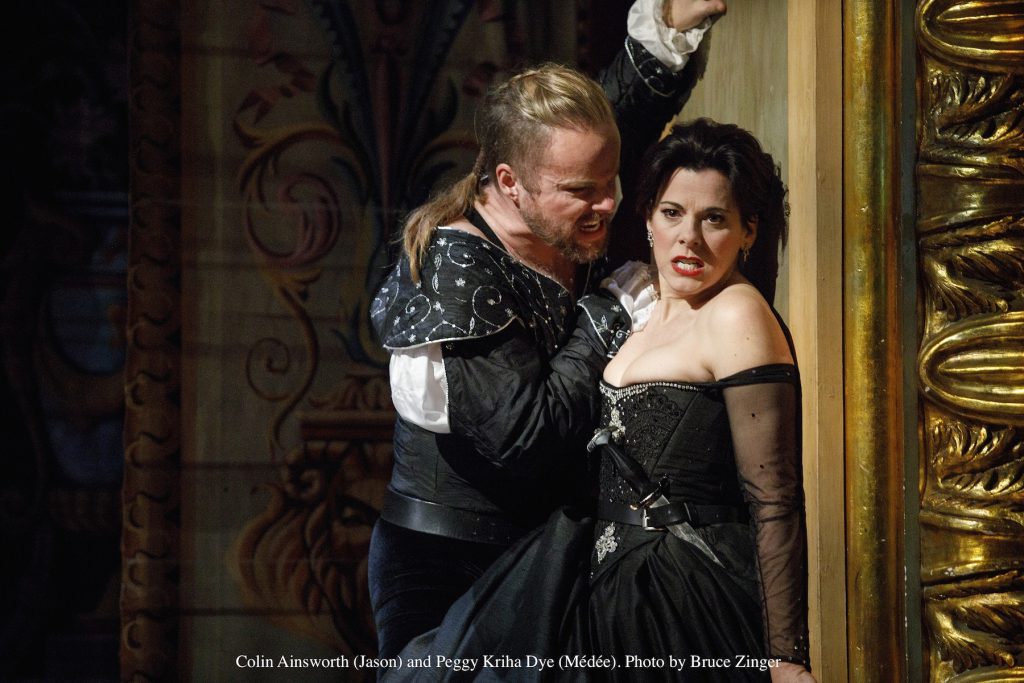December 4, 1693. A spectacular new opera commissioned by the Académie Royale de Musique opens in Paris. The city is abuzz. The Dauphin is present at two performances. The Duc d’Orléans, brother of Louis XIV, attends no less than four. Both pronounce the rollicking epic, a career breakthrough by composer Marc-Antoine Charpentier, a tour de force. The ubiquitous society gazette, the Mercure galant, declares it a must-see. Audiences fill the Théâtre du Palais-Royal for the duration of the three month run.
Then, suddenly, with no apparent explanation, Charpentier’s action-packed extravaganza utterly disappears from history. Not until 1984 is it revived when early music pioneer William Christie and Les Arts Florissants unveil a landmark production at the Théâtre des Champs-Elysées.
The total absence of Charpentier’s Medea from the world opera stage for over three centuries is puzzling to say the least. The work was unquestionably controversial when first presented. To Parisian devotees of trendy Italian musical theatre, the eponymous Italienistes, Charpentier’s emotionally intense five-act thriller represented a bracing alternative to the staid, hidebound tragédies lyriques of the French Baroque. To the highly vocal, more traditionally minded champions of Gallic artistic ideals, the Lullistes, Medea was nothing more than a vulgar piece of artless sensationalism.
What went unsaid by either side in the debate by all accounts was the fact that, like Charpentier who journeyed from Paris to Rome as a student eager to absorb the native musical vernacular, Jean-Baptiste Lully, born Giovanni Battista Lulli, recently deceased surintendant de la musique du roi, had embarked on something of a similar mission 40 years earlier, geography reversed.
Irony aside, artistic wrangling, however inflamed, seems a singularly inadequate explanation for Medea’s untimely demise. Big, boisterous and brawling, the opera may very well have proven simply de trop for everyone.
Revelling in the sheer glory of Medea’s extravagance, Opera Atelier restores its sumptuous 2002 production of Charpentier’s sweeping masterpiece to life with a magnificent renovation, exquisitely restaged, thrillingly performed. Burrowing deep into the darkness of classical opera noir, director Marshall Pynkoski unearths a labyrinth of shadowy meaning and raw emotion in the savage, archetypal tale.
Authored by librettist and playwright Thomas Corneille, brother of the eminent tragedian Pierre Corneille, Medea mines the darkest, innermost recesses of the psyche. As was the prevailing convention, Charpentier and his seasoned collaborator placed their ferocious opera seria at the centre of myth and legend. Prior knowledge of backstory was expected as was the audience’s appetite for dense, cathartic drama.
Fleeing in the wake of bloody violence and treachery following the theft of the Golden Fleece, the sorceress Médée and her lover Jason seek sanctuary in the kingdom of Créon, pursued by Acastus, son of King Pelleas of Thessaly whom Médée has killed.
ACT 1
Sensing Jason’s devotion is fading, Médée confides her misgivings to her handmaiden, Nérine. Though he professes to pay court to Créuse, daughter of the King, merely to secure Créon’s favour, Médée’s instincts tell her otherwise. Jason scornfully dismisses her fears only to confess his true feelings a short time later to friend and confidant Arcas. Arcas warns that Jason’s love for Créuse threatens to ignite Médée’s fury. The situation is made even more perilous by the betrothal of Créuse to another, Oronte of Argos. King Créon is in dire need of the foreign Prince as an ally. Acastus is poised to invade.
ACT 2
Créon shocks Médée with his terse demand that she depart his kingdom for the sake of civil order. His people fear her continued presence augurs disaster in the war to come. Jason, who he secretly favours as son-in-law and heir, is to remain in Corinth as are the children Médée bore him. Enraged and anguished, Médée exits.
ACT 3
Médée rails at Créon’s duplicity. The King, she strongly suspects, only wishes her exiled in order to facilitate a union between Jason and his daughter. Oronte begs Médée’s aid to hasten his marriage to Créuse, promising to shelter the sorceress from harm in the land of Argos. The two vow to support one another. Jason enters to bid Médée a brusque farewell, arguing the vicissitudes of war decree her banishment. His infidelity confirmed by follow-up news from Nérine via Arcas, Médée explodes into a rage, summoning her infernal powers to arouse the spirits of Vengeance and Jealousy. A golden gown long coveted by Créuse is magically infused with poison.
ACT 4
Jason marvels at Créuse’s beauty made ever more striking by the gleaming garment Médée has gifted to her. Oronte arrives spewing bitter accusations of faithlessness and deception. Médée upholds his claims, pledging Créuse shall never be Jason’s bride. Créon and his bodyguard burst in. Médée renders the troop helpless with a powerful enchantment spell. Créon is driven mad.
ACT 5
Créuse desperately begs Médée to relent. Médée willingly agrees but only when she has seen the Princess married to Oronte. News arrives that Créon, violent and raving, has slain the much abused Prince then turned his sword on himself. Créuse lashes out at her father’s tormentor. Médée caresses her rival’s bewitched gown, instantly releasing its fatal toxins. Créuse suffers a painful death. Still Médée is not content. Jason’s children are slaughtered, Créon’s palace annihilated. The remorseless sorceress ascends into the heavens, flying from the apocalyptic scene.
An abundance of ominous psychology is on graphic display in this tortured yarn. Simultaneously hyper-acute and emotionally precarious, unable to commit to a present existence, Médée wrestles with her past. Steeped in brutality and bloodshed, the passionate sorceress and murderer struggles to heed Nérine’s advice. Forcez vos ennuis au silence. Un courroux violent ne doit jamais parler. (“Constrain your unhappiness to silence. Violent rage should never speak.”) But agonizing feelings of betrayal are not so easily repressed. And Jason, eternal narcissist, not so effortlessly reclaimed. Créon, the power-clinging immoraliste blocks any hope of bringing order out of chaos. Médée is forced into a single monstrous act to rid herself of her demons, a cold, hideously skewed expression of grotesque free will. The murder of her children is a waking nightmare, horrifically reasonable in its ghastly irrationality.
As vivid as the implicit psychodrama may be, however, it is not necessarily the first level of active reality to make an impression in this decidedly accessible Medea. Countless outward physical expressions of character signal inner turmoil long before a wave of deeper understanding breaks. Médée’s compulsive palms-up double hand gesture warns aggressors not to proceed closer. Collapsed bodies on stage speak of surrender to love, brutality, fate. Bold contrapposto poses, a staple of 17th century theatrics, seem to take on fresh meaning, reflecting a once heroic world on the edge of equilibrium. The moments are fleeting, evocative, acutely observed. OA’s Medea draws its power as much from the interplay of the intimate and the human as it does from dynamic action scenes and panoramic tableau. Pynkoski’s flair for rapidly zooming his directorial lens from close-up to wide angle gives Medea a tautness and sense of surprise that utterly engages.
With the vitality and poise of Baroque ballet focused centre stage, choreographer Jeanette Lajeunesse Zingg delivers some of the best work of her career. Where dance animates divertissements, swirling pageantry prevails. Where it is fluidly integrated into story, drama leaps forward. The flawless corps de ballet is a vision of synchronicity. The lovely dance of the enchanting maidens that graces Act IV, veiled apparitions afloat in the mist, is simply spellbinding. Stepping forward from the splendid company of male artists, Jeremy Nasmith executes a spectacular solo as a gravity-defying Argian chevalier, double swords flashing, daringly airborne throughout much of the surrounding mock battle scene.
On the musical side of the production, Charpentier’s genius for embedding character and emotion in his notation is much in evidence in OA’s 2017 Medea. Blending Italian lyricism with a firm command of French word-painting, one of opera’s first internationalist composers created a highly innovative work rich in colour tinted with a hint of dissonance. Weaving together tightly packed strands of texture and harmony, conductor David Fallis treats Charpentier’s flowing, through-composed score with unremitting intelligence and refinement. The Tafelmusik Baroque Orchestra plays with a superb unity of voice. Flutes and percussion are particularly finely aligned.
Singing Medea’s title role, Peggy Kriha Dye, a frequent visitor to Opera Atelier, turns in an exquisite performance of supreme artistry, riveting in its intensity. Unconstrained by Charpentier’s rejection of stand-alone arie da capo in favour of more fluent arioso and accompanied recitative, the vibrant American soprano conveys an inexpressibly affecting rendition of the composer’s sorrowful Act 3 plaint, Quel prix de mon amour (“Is this the price of my love?”). Deservedly celebrated as the opera’s vocal centrepiece, Kriha Dye renders the poignant lament heartbreaking.
Appearing as Jason, tenor Colin Ainsworth is a powerhouse, channelling his big lusty instrument with almost rash abandon, impulsive and dangerous. Fearlessly employing a somewhat more unvarnished tone than Kriha Dye, the versatile Toronto-based singer actor positively shreds his frequent strapping duets with her, flinging us headlong into the midst of their crumbling partnership with his potent contribution to their first tart encounter, D’où vo’ vient cet air sombre? (“Whence come you with this black brow?”) This is an on-stage team of some considerable ferocity.
Bass-baritone Stephen Hegedus sings a magnificently perfidious Créon, sonorous and threatening. Soprano Mireille Asselin embodies Créuse, the King’s precious daughter, perhaps not quite as innocent as her sweet, lilting timbre might suggest. Baritone Jesse Blumberg is the lovelorn Prince Oronte, all guilelessness and open notes.
Sopranos Meghan Lindsay and Karine White are handmaidens Nérine and Cléone respectively, busybodies both. Olivier Laquerre is an exasperated Arcas. Karine White appears as an airy Cupidon, cleverly assuming an innocent boy soprano air.
Singing from a darkened loge in Médée’s current gilded haunts at Toronto’s Elgin Theatre, the 18-voice strong Tafelmusik Chamber Choir fills the night with ethereal anthems.
Bound for the Opéra Royal de Versailles in mid May as part of Canada’s Sesquicentennial celebrations in France, Opera Atelier’s electrifying, explosive Medea returns Charpentier’s timeless work to its artistic roots. That Pynkoski, Lajeunesse Zingg and colleagues have been invited to present it at the historic epicentre of French Baroque art and fashion is testament to the company’s proven reputation for period sensitivity and discerning innovation. This exceptional collection of artists is to be deeply cherished.


